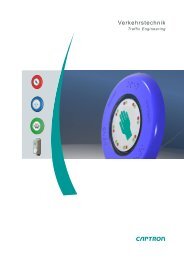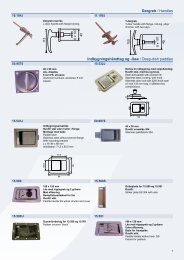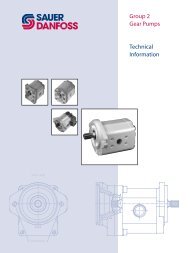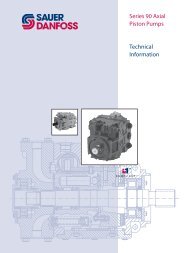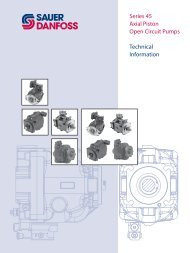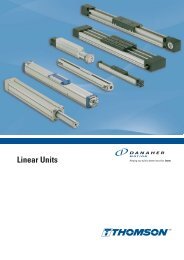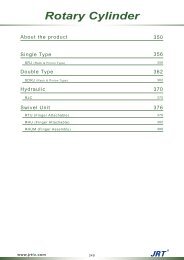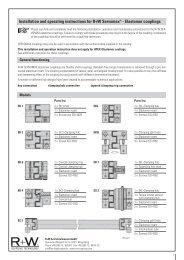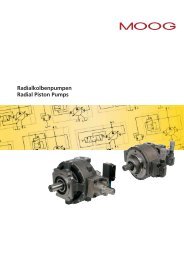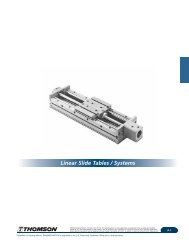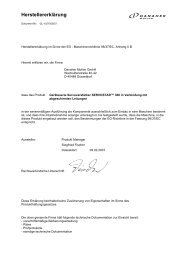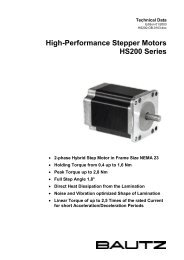You also want an ePaper? Increase the reach of your titles
YUMPU automatically turns print PDFs into web optimized ePapers that Google loves.
Technical Notes (Continued)<br />
Torque vs. Speed Characteristics<br />
Many factors determine the torque vs. speed characteristics of a<br />
Step Motor. These include the design of the drive system and the<br />
voltage supplied to the motor, as well as the inductance rating of<br />
the motor used.<br />
Effects of Drive Design<br />
Drive design is an important factor in determining the overall<br />
performance which will be obtained. The types of drives, and their<br />
effects on motor performance, are as follows:<br />
L/R Drives – This design was the basis for most older drives and is<br />
still used on some existing drives. It allows half-or full-<strong>step</strong> motor<br />
operation, but does not permit variable control of current level.<br />
L/R drives also require dropping resistors, which reduce motor<br />
efficiency. L/R drives provide satisfactory performance at lower<br />
<strong>step</strong>ping rates, but do not have good high speed capabilities. This<br />
is the most basic drive design.<br />
Constant Current Chopper Drives – These drives maintain<br />
relatively constant current to the motor at all speeds, and therefore<br />
offer good <strong>step</strong>ping performance at rates up to approximately<br />
10,000 <strong>step</strong>s per second. Although more costly and complex than<br />
L/R drives, they allow use of features such as closed-loop control,<br />
micro<strong>step</strong>ping, current boost, and stabilization that improve motor<br />
performance.<br />
Line Operated, High Voltage Chopper Drives – These drives deliver<br />
higher voltage to the motor for optimum high speed performance.<br />
They are also able to operate larger <strong>motors</strong> to provide high<br />
performance and excellent efficiency. Since they do not need bulky<br />
<strong>step</strong>down transformers, line operated drives are more compact<br />
than other chopper drives.<br />
Effects of Motor Voltage<br />
Motor performance at mid-range and high-range speeds can be<br />
improved by increasing the voltage to the motor. However, the<br />
motor will operate at a high temperature when the voltage is<br />
increased, so some means of cooling may be necessary. In general,<br />
motor supply voltage does not affect operation at lower speeds.<br />
Motor Inductance Effects<br />
For a given supply voltage, a low inductance motor will give better<br />
performance at high speeds than a high inductance motor, but will<br />
operate at a higher temperature. This is true because current will<br />
increase faster in a low inductance winding, each time the winding<br />
power is switched. High inductance <strong>motors</strong> yield higher<br />
maximum torque and operate cooler, but their top speed is limited<br />
and torque falls off more rapidly as speed rises, versus a lower<br />
inductance motor.<br />
Angular Position Deviation<br />
When a load is applied to a<br />
<strong>step</strong> motor shaft, the shaft<br />
will rotate slightly from the<br />
no load position. The<br />
Angular Position Deviation<br />
curve shows shaft deviation<br />
from the no load position<br />
vs. percent of rated holding<br />
torque. This curve is valid<br />
for all <strong>Superior</strong> <strong>Electric</strong><br />
1.8° <strong>step</strong> <strong>motors</strong>.<br />
STEP MOTORS<br />
NOTE: Proper construction<br />
of the mechanism of the<br />
driven load is essential in order to accurately achieve a true<br />
versus theoretical position.<br />
Connection Diagrams<br />
NOTE: Numbers identify terminal board connections.<br />
www.DanaherMotion • 704-588-5693<br />
31



